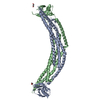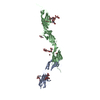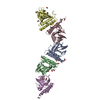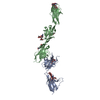+ Open data
Open data
- Basic information
Basic information
| Entry | Database: EMDB / ID: EMD-21325 | |||||||||
|---|---|---|---|---|---|---|---|---|---|---|
| Title | Focused Classification of FIP200 NTD | |||||||||
 Map data Map data | Final FIP200 NTD Map | |||||||||
 Sample Sample |
| |||||||||
| Function / homology |  Function and homology information Function and homology informationAtg1/ULK1 kinase complex / ribophagy / glycophagy / phagophore assembly site membrane / pexophagy / autophagy of mitochondrion / piecemeal microautophagy of the nucleus / phagophore assembly site / reticulophagy / Macroautophagy ...Atg1/ULK1 kinase complex / ribophagy / glycophagy / phagophore assembly site membrane / pexophagy / autophagy of mitochondrion / piecemeal microautophagy of the nucleus / phagophore assembly site / reticulophagy / Macroautophagy / autophagosome membrane / autophagosome assembly / positive regulation of cell size / extrinsic apoptotic signaling pathway / protein-membrane adaptor activity / positive regulation of autophagy / negative regulation of extrinsic apoptotic signaling pathway / positive regulation of JNK cascade / liver development / autophagy / heart development / nuclear membrane / defense response to virus / molecular adaptor activity / lysosome / negative regulation of cell population proliferation / innate immune response / endoplasmic reticulum membrane / protein kinase binding / cytosol Similarity search - Function | |||||||||
| Biological species |  Homo sapiens (human) Homo sapiens (human) | |||||||||
| Method | single particle reconstruction / cryo EM / Resolution: 8.4 Å | |||||||||
 Authors Authors | Yokom AL / Shi X / Hurley JH | |||||||||
 Citation Citation |  Journal: J Cell Biol / Year: 2020 Journal: J Cell Biol / Year: 2020Title: ULK complex organization in autophagy by a C-shaped FIP200 N-terminal domain dimer. Authors: Xiaoshan Shi / Adam L Yokom / Chunxin Wang / Lindsey N Young / Richard J Youle / James H Hurley /  Abstract: The autophagy-initiating human ULK complex consists of the kinase ULK1/2, FIP200, ATG13, and ATG101. Hydrogen-deuterium exchange mass spectrometry was used to map their mutual interactions. The N- ...The autophagy-initiating human ULK complex consists of the kinase ULK1/2, FIP200, ATG13, and ATG101. Hydrogen-deuterium exchange mass spectrometry was used to map their mutual interactions. The N-terminal 640 residues (NTD) of FIP200 interact with the C-terminal IDR of ATG13. Mutations in these regions abolish their interaction. Negative stain EM and multiangle light scattering showed that FIP200 is a dimer, while a single molecule each of the other subunits is present. The FIP200NTD is flexible in the absence of ATG13, but in its presence adopts the shape of the letter C ∼20 nm across. The ULK1 EAT domain interacts loosely with the NTD dimer, while the ATG13:ATG101 HORMA dimer does not contact the NTD. Cryo-EM of the NTD dimer revealed a structural similarity to the scaffold domain of TBK1, suggesting an evolutionary similarity between the autophagy-initiating TBK1 kinase and the ULK1 kinase complex. | |||||||||
| History |
|
- Structure visualization
Structure visualization
| Movie |
 Movie viewer Movie viewer |
|---|---|
| Structure viewer | EM map:  SurfView SurfView Molmil Molmil Jmol/JSmol Jmol/JSmol |
| Supplemental images |
- Downloads & links
Downloads & links
-EMDB archive
| Map data |  emd_21325.map.gz emd_21325.map.gz | 111.6 KB |  EMDB map data format EMDB map data format | |
|---|---|---|---|---|
| Header (meta data) |  emd-21325-v30.xml emd-21325-v30.xml emd-21325.xml emd-21325.xml | 12.1 KB 12.1 KB | Display Display |  EMDB header EMDB header |
| Images |  emd_21325.png emd_21325.png | 34.5 KB | ||
| Others |  emd_21325_half_map_1.map.gz emd_21325_half_map_1.map.gz emd_21325_half_map_2.map.gz emd_21325_half_map_2.map.gz | 20.7 MB 20.7 MB | ||
| Archive directory |  http://ftp.pdbj.org/pub/emdb/structures/EMD-21325 http://ftp.pdbj.org/pub/emdb/structures/EMD-21325 ftp://ftp.pdbj.org/pub/emdb/structures/EMD-21325 ftp://ftp.pdbj.org/pub/emdb/structures/EMD-21325 | HTTPS FTP |
-Validation report
| Summary document |  emd_21325_validation.pdf.gz emd_21325_validation.pdf.gz | 78.9 KB | Display |  EMDB validaton report EMDB validaton report |
|---|---|---|---|---|
| Full document |  emd_21325_full_validation.pdf.gz emd_21325_full_validation.pdf.gz | 78 KB | Display | |
| Data in XML |  emd_21325_validation.xml.gz emd_21325_validation.xml.gz | 494 B | Display | |
| Arichive directory |  https://ftp.pdbj.org/pub/emdb/validation_reports/EMD-21325 https://ftp.pdbj.org/pub/emdb/validation_reports/EMD-21325 ftp://ftp.pdbj.org/pub/emdb/validation_reports/EMD-21325 ftp://ftp.pdbj.org/pub/emdb/validation_reports/EMD-21325 | HTTPS FTP |
-Related structure data
| Similar structure data |
|---|
- Links
Links
| EMDB pages |  EMDB (EBI/PDBe) / EMDB (EBI/PDBe) /  EMDataResource EMDataResource |
|---|
- Map
Map
| File |  Download / File: emd_21325.map.gz / Format: CCP4 / Size: 22.2 MB / Type: IMAGE STORED AS FLOATING POINT NUMBER (4 BYTES) Download / File: emd_21325.map.gz / Format: CCP4 / Size: 22.2 MB / Type: IMAGE STORED AS FLOATING POINT NUMBER (4 BYTES) | ||||||||||||||||||||||||||||||||||||||||||||||||||||||||||||||||||||
|---|---|---|---|---|---|---|---|---|---|---|---|---|---|---|---|---|---|---|---|---|---|---|---|---|---|---|---|---|---|---|---|---|---|---|---|---|---|---|---|---|---|---|---|---|---|---|---|---|---|---|---|---|---|---|---|---|---|---|---|---|---|---|---|---|---|---|---|---|---|
| Annotation | Final FIP200 NTD Map | ||||||||||||||||||||||||||||||||||||||||||||||||||||||||||||||||||||
| Projections & slices | Image control
Images are generated by Spider. | ||||||||||||||||||||||||||||||||||||||||||||||||||||||||||||||||||||
| Voxel size | X=Y=Z: 2.274 Å | ||||||||||||||||||||||||||||||||||||||||||||||||||||||||||||||||||||
| Density |
| ||||||||||||||||||||||||||||||||||||||||||||||||||||||||||||||||||||
| Symmetry | Space group: 1 | ||||||||||||||||||||||||||||||||||||||||||||||||||||||||||||||||||||
| Details | EMDB XML:
CCP4 map header:
| ||||||||||||||||||||||||||||||||||||||||||||||||||||||||||||||||||||
-Supplemental data
-Half map: Half Map B
| File | emd_21325_half_map_1.map | ||||||||||||
|---|---|---|---|---|---|---|---|---|---|---|---|---|---|
| Annotation | Half Map B | ||||||||||||
| Projections & Slices |
| ||||||||||||
| Density Histograms |
-Half map: Half Map A
| File | emd_21325_half_map_2.map | ||||||||||||
|---|---|---|---|---|---|---|---|---|---|---|---|---|---|
| Annotation | Half Map A | ||||||||||||
| Projections & Slices |
| ||||||||||||
| Density Histograms |
- Sample components
Sample components
-Entire : FIP200 NTD Focused Classification Monomer
| Entire | Name: FIP200 NTD Focused Classification Monomer |
|---|---|
| Components |
|
-Supramolecule #1: FIP200 NTD Focused Classification Monomer
| Supramolecule | Name: FIP200 NTD Focused Classification Monomer / type: complex / ID: 1 / Parent: 0 |
|---|---|
| Source (natural) | Organism:  Homo sapiens (human) Homo sapiens (human) |
| Recombinant expression | Organism:  Homo sapiens (human) / Recombinant strain: HEK293T Homo sapiens (human) / Recombinant strain: HEK293T |
-Experimental details
-Structure determination
| Method | cryo EM |
|---|---|
 Processing Processing | single particle reconstruction |
| Aggregation state | particle |
- Sample preparation
Sample preparation
| Buffer | pH: 7.5 |
|---|---|
| Vitrification | Cryogen name: ETHANE / Chamber humidity: 100 % / Chamber temperature: 20 K / Instrument: FEI VITROBOT MARK IV |
- Electron microscopy
Electron microscopy
| Microscope | FEI TALOS ARCTICA |
|---|---|
| Image recording | Film or detector model: GATAN K3 (6k x 4k) / Average electron dose: 60.0 e/Å2 |
| Electron beam | Acceleration voltage: 200 kV / Electron source:  FIELD EMISSION GUN FIELD EMISSION GUN |
| Electron optics | C2 aperture diameter: 50.0 µm / Illumination mode: FLOOD BEAM / Imaging mode: BRIGHT FIELD / Cs: 2.7 mm |
| Experimental equipment |  Model: Talos Arctica / Image courtesy: FEI Company |
- Image processing
Image processing
| CTF correction | Software - Name: CTFFIND (ver. 4) |
|---|---|
| Final reconstruction | Resolution.type: BY AUTHOR / Resolution: 8.4 Å / Resolution method: FSC 0.143 CUT-OFF / Number images used: 29198 |
| Initial angle assignment | Type: RANDOM ASSIGNMENT |
| Final angle assignment | Type: MAXIMUM LIKELIHOOD |
 Movie
Movie Controller
Controller












 Z (Sec.)
Z (Sec.) Y (Row.)
Y (Row.) X (Col.)
X (Col.)





































